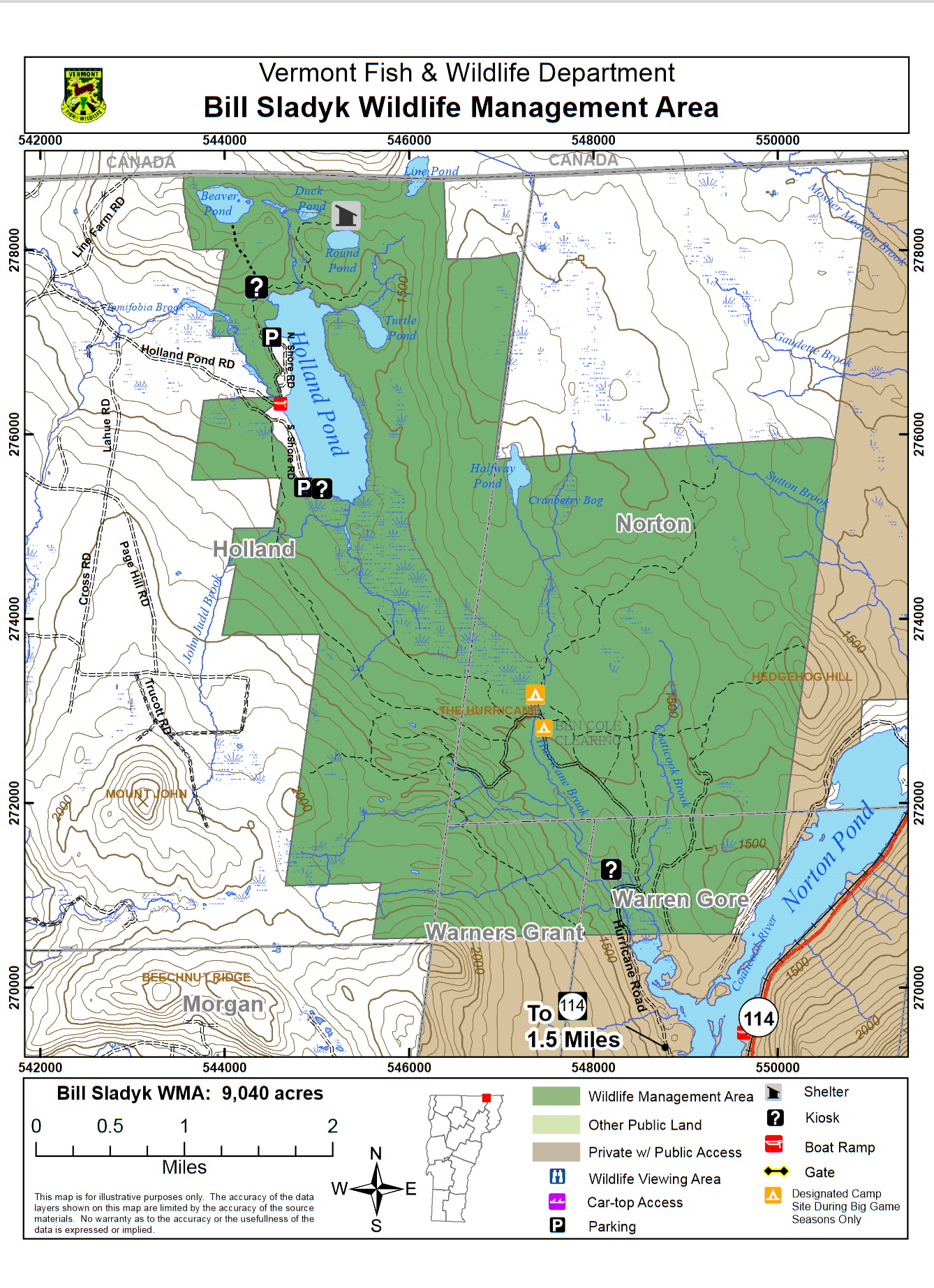Bill Sladyk WMA
Tips for Birding
When submitting eBird observations at Bill Sladyk Wildlife Management Area, it is most helpful to start a new checklist for each hotspot in the wildlife aea. Use the general hotspot when you have a checklist that includes multiple locations or if no other hotspot or personal location is appropriate for your sightings.
Birds of Interest
Birds of Interest Favorable ruffed grouse habitat exists in the vicinity of the Ben Cole Clearing, where the Department has created grouse habitat units. The units consist of a checkerboard pattern of small clear-cuts of various age classes that provide the habitat required for breeding, nesting, brooding, and winter roosting.
The great variety of forest and wetland habitats provides excellent bird-watching prospects. Opportunities exist to view boreal chickadees in the expansive areas of spruce and fir. A pair of State Endangered common loons can be found during the summer months nesting on Holland Pond.
About Bill Sladyk Wildlife Management Area
See all hotspots at Bill Sladyk Wildlife Management Area
The Bill Sladyk Wildlife Management Area (WMA) is an approximate 9,040-acre parcel of land owned and managed by the Vermont Fish and Wildlife Department. The WMA is located 8 miles north of Island Pond on VT-114 and ranges from Norton Pond, northwest to the Canadian Border just north of Holland Pond. The management goals of this property are to protect and enhance the many different habitat types present.
In 1983 the WMA name was changed from the Hurricane Brook WMA to the Bill Sladyk WMA in memory of State Wildlife Forester William F. Sladyk. The present-day landholdings of the WMA were acquired from 1959 to 1998 using several different funding mechanisms. The Department purchased the largest tracts in 1959 using monies from the sale of hunting and fishing licenses. It was not until 1970 however that the Department finally purchased the timber rights to the property from the Fillemore Lumber Company of Stanstead, Quebec. The latest addition to the WMA came in 1998 when the Department purchased 115 acres surrounding the southern end of Holland Pond. This latest purchase was made using funds derived from the Federal Aid in Wildlife Restoration Act, otherwise known as the Pittman-Robertson Program. This program is funded by an eleven percent manufacturer’s excise tax on rifles, shotguns, ammunition, and archery equipment. This addition to the WMA allows for the protection of 10,000 feet of undeveloped shoreline around Holland Pond.
Elevations on the WMA range from 1400 feet along Hurricane Brook to 2000 feet on an unnamed summit east of Beechnut Ridge. The terrain varies from flat cedar swamps to rolling hardwood hills. The property is nearly 100% forested, comprised of red maple, sugar maple, American beech, yellow birch, paper birch, black cherry, red and black spruce, balsam fir, and white cedar. Since acquiring the property, the Department has undertaken many different projects to enhance the value of the land for wildlife. Several old log landings have been disked, re-seeded, and periodically brush-hogged to provide openings in the heavily forested landscape. An 85-acre grouse unit located in the vicinity of the Ben Cole Clearing has been managed with the primary goal of creating optimum grouse habitat. The Department has also been actively restoring historical deer wintering habitat along the Coaticook and Hurricane brooks.
An excellent diversity of wetland habitats can be found throughout the WMA. Two wetlands of ecological significance on the WMA include Cranberry Bog and Halfway Pond. Cranberry Bog is a 26-acre peatland bog with stunted tamaracks, black spruce, and the carnivorous pitcher plant. Halfway Pond is one of the most pristine spruce-lined ponds in Essex County. The WMA also contains many scattered beaver impoundments, many small brooks, the 334-acre Holland Pond, as well as the smaller Beaver, Duck, Round, Line, and Turtle Ponds.
The many ponds, streams, and beaver impoundments on the WMA provide suitable habitat for nesting and migrating waterfowl. The most commonly seen species include Mallards, Black Ducks, Goldeneyes, Ring-neck ducks, Wood ducks, and both Common and Hooded Mergansers.
Features
Restrooms on site
Wheelchair accessible trail
Entrance fee
Content from Bill Sladyk Wildlife Management Area guide and map
Last updated October 18, 2023
